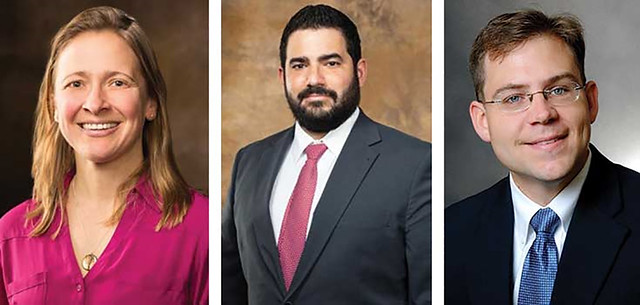April 9, 2021
Grant funds Arkansas scientists research on medicine patch for cattle
By Christin R. Finney
College of Engineering
479-575-4173, crn002@uark.edu
Fast facts
- Division of Agriculture, U of A College of Engineering earn grant for collaboration
- Team developed patch to administer pain medication to cattle
- USDA-NIFA awarded $500,000 grant
(482 words)
Download related PHOTO: https://flic.kr/p/2kS6BEg
FAYETTEVILLE, Ark. — An Arkansas Agricultural Experiment Station animal scientist and two University of Arkansas chemical engineers earned a $500,000 grant to continue research in pain management for cattle during routine procedures.
Jeremy G. Powell, professor of animal science for the Agricultural Experiment Station, the research arm of the University of Arkansas System Division of Agriculture; Jorge Almodovar, assistant professor of chemical engineering; and Lauren F. Greenlee, associate professor of chemical engineering, received the grant from the U.S. Department of Agriculture’s National Institute of Food and Agriculture.
The four-year USDA-NIFA grant supports continued research to evaluate a chitosan-based, biodegradable microneedle patch developed by the research team to deliver meloxicam for pain relief to cattle undergoing routine procedures such as castration.
The funding will also support the education of two or more graduate students in animal science and engineering.
Meloxicam is a pain medication used in veterinary applications. However, in the U.S. it has limited uses in cattle mainly due to short duration formulations, Powell said. “Our team has engineered a microneedle patch using the biodegradable polymer chitosan, or crustacean shells, which is capable of delivering meloxicam when applied transdermally, through the skin.
“This project will further explore the capacity of these patches to manage pain,” Powell said.
According to the National Institute of Biomedical Imaging and Bioengineering (https://www.nibib.nih.gov), the microneedles dissolve within minutes after insertion into skin to release an encapsulated drug or vaccine.
In spring 2019, the same team was selected for funding by the Chancellor’s Fund for Innovation and Collaboration. Those initial funds were used to support graduate students in chemical engineering and animal science who generated the preliminary data necessary to pursue the USDA grant.
“This is a tremendous achievement by the team,” Almodovar said, “because it shows how the initial investment by the Chancellor’s Innovation and Collaboration Fund can be leveraged to secure additional funding. So far, this project has resulted in a provisional patent application, a peer-reviewed publication, several presentations at national conferences and now a funded federal grant.”
Jeremy Powell is a doctor of veterinary medicine and professor in the department of animal science for the Division of Agriculture and the Dale Bumpers College of Agricultural, Food and Life Sciences. His primary research focuses on beef cattle health.
Almodovar holds the Ray C. Adam Chair and is assistant professor in the Ralph E. Martin Department of Chemical Engineering. He also serves as the NSF-funded Bridge-to-the-Doctorate site director at the U of A. His research focus is on polymeric biomaterials for applications in cell manufacturing, tissue engineering, drug delivery and water treatment.
Lauren Greenlee is an associate professor and holds the Ralph E. Martin Leadership Chair in chemical engineering. Her research focuses on water chemistry, nanomaterials and electrochemistry. A branch of physical chemistry, electrochemistry is the study of the relationship between electricity and chemical change, including reactions and outcomes derived from the application of one to the other.
To learn more about Division of Agriculture research, visit the Arkansas Agricultural Experiment Station website. Follow us on Twitter at @ArkAgResearch.
About the Division of Agriculture
The University of Arkansas System Division of Agriculture’s mission is to strengthen agriculture, communities, and families by connecting trusted research to the adoption of best practices. Through the Agricultural Experiment Station and the Cooperative Extension Service, the Division of Agriculture conducts research and extension work within the nation’s historic land grant education system.
The Division of Agriculture is one of 20 entities within the University of Arkansas System. It has offices in all 75 counties in Arkansas and faculty on five system campuses.
Pursuant to 7 CFR § 15.3, the University of Arkansas System Division of Agriculture offers all its Extension and Research programs and services (including employment) without regard to race, color, sex, national origin, religion, age, disability, marital or veteran status, genetic information, sexual preference, pregnancy or any other legally protected status, and is an equal opportunity institution.
About the Chancellor’s Innovation and Collaboration Fund: Since its establishment in 2016, the Chancellor’s Fund has invested up to $1 million annually in seed funding. Faculty pursuing interdisciplinary studies in the university’s signature research areas are encouraged to apply for the Collaboration and Innovation Fund. The three signature areas identified by the U of A are Advancing the Data Revolution, Improving Human Health and Community Vibrancy, and Innovating a Resilient and Sustainable Future.
Media Contact: Fred Miller
U of A System Division of Agriculture
Arkansas Agricultural Experiment Station
(479) 575-5647
fmiller@uark.edu
Related Links
